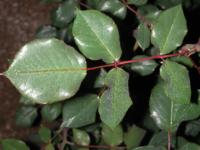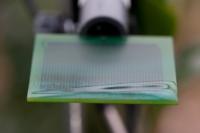Scouting for diseases and environmental monitoring
by Steve Tjosvold
Regular scouting for the earliest occurrence of disease is essential. Check plants at least weekly for symptoms of diseases and record disease occurrence, severity and environmental or other conditions that favored the disease. Learn what diseases are known to be associated with the crops you are growing. Focus attention on diseases that historically are found in your nursery or are supported by the current environmental conditions. Look for off-color or irregular growth, wilting, soft or necrotic areas on leaves or stems. Remove root balls from containers and look for root disease symptoms: necrotic lesions, galls and rots on roots or near the root crowns. A 10x hand lens can be helpful to take a close look at unhealthy plants in the field. Sometimes characteristic spores or other signs of the pathogen might be visible and aid in field identification. Often pathogens are not readily identified in the field because identification and diagnosis may require more analysis and specialized techniques that are only available in a plant pathology laboratory.
Make note and look for patterns where unhealthy plants or unhealthy portions of the plant are found. Collect plant samples that represent all apparent developmental stages of the disease. For example, cyclamen infected with Fusarium oxysporum f.sp. cyclaminis might be first noticed when some plants begin to become less vigorous as compared to healthy plants. Corms may have some internal discoloration. With more time, wilting might occur, at first, just on one side of the plant. In the final stages of the disease, the plant leaves become necrotic and the plant collapses. If present, all these stages should be sampled. Don’t forget to collect some healthy plants or plant parts that can be used to compare against the unhealthy portions.
Samples may need to be examined more closely by a plant pathologist and laboratory analysis performed to positively identify if any pathogens are present in affected plant parts. Commercially available detection kits can be used for the detection of some pathogens at the nursery, and the test takes as little as 10 minutes. ImmunoStrip® tests (AgDia Inc. Elkhart IN) use ELISA technology where antibodies are used to recognize proteins that are unique to specific pathogens such as Phytophthora species, bacteria and viruses. A variant of the ELISA method is a portable lateral flow device known as Pocket Diagnostic® (Abingdon Health Products, York, UK).
Diseases are mostly managed by preventative measures and chemical controls. Fungicides and bactericides usually must be applied before infection occurs. (The exception are powdery mildew diseases, which potentially could be eradicated by some fungicides.) Early detection of diseases definitely helps so protective sprays might be applied to unaffected plants. Yet, often it is impossible to see what is actually infected since overt symptoms might not have developed yet.
Since diseases must be managed preventatively, monitoring conditions that promote diseases and unhealthy plants is very important. Crops should be inspected for issues that might cause plant problems such as under- or over-watering, fertilizer injector problems, pesticide mixing problems, and thermostat inaccuracy or heater breakdowns.
Environmental monitoring, particularly humidity and leaf wetness, is especially important. The majority of fungi, aerial nematodes and bacteria that cause plant diseases require liquid “free” water on the plant surfaces before they can infect the plant. Free water could be in the form of rain, fog, dew, sprinkler irrigation water, syringing water, or even pesticide spray. Moreover, many fungi need high humidity to produce spores. Dew formation is triggered when the surface temperature of a leaf canopy drops below the dew point temperature of the surrounding air (fig 1).
Fig. 1. Dew formed at night on leaf and other plant surfaces create the favorable conditions for pathogen infection. Photo: S. Tjosvold.

Table 1. The effect of wet period on Botrytis cinerea infection of ‘Volare’ and ‘Magic Carousel’ roses.
| 'Volare' | 'Magic Carousel' | ||
| wet Period | Disease index1 | wet period | Disease index1 |
| hours | hours | ||
| 4 | 1.67 | 4 | 0.33 |
| 5 | 2.22 | 8 | 0.89 |
| 6 | 3.56 | 12 | 1.22 |
| 24 | 4.00 | 24 | 3.67 |
1Disease index (0 to 5 ) 0 = no infections, 5 = all or nearly all petal tissue necrotic. Numbers in the same column followed by the same letters are not statistically different. Source: D. Coyier 1986.
Commercial disease prediction models exist for apple scab, cedar apple rust, potato late blight, tomato early blight, strawberryanthracnose,botrytis fruit rot, citrus brown spot, lettuce downy mildew, grape powdery mildew, among others. Sensors quantify and collect leaf wetness duration and models predict disease risk (fig 2).

These systems can reduce the number of sprays that are needed for disease control. It has been recently suggested that disease models instead use leaf wetness data based on a simple empirical model using relative humidity. Relative humidity sensors can be standardized and calibrated more easily than leaf wetness sensors.
Many current greenhouse control systems can help collect and organize data from leaf wetness, relative humidity and temperature sensors. Alternatively, a simple environmental monitoring system can be pieced together for an outdoor nursery or greenhouse using readily available sensors and dataloggers from various companies (e.g., Campbell Scientific Inc (Logan, UT), Onset (Bourne, MA), Spectrum Technologies Inc. (Aurora, IL). Most disease risk models have not been tested in ornamental crops but there is no reason why they cannot be wholly or partly used for disease risk monitoring in ornamental crops. Botrytis models have been intensively studied in other crops and should be one of the first to try in ornamental crops. Empirical evaluation of these models in the field is a first step to confirm their usefulness. Models that predict high disease risk could improve scouting efficiency by targeting more intensive scouting during these periods, help to reduce fungicide applications by predicting optimal timing of fungicides before infection occurs, and target periods when dehumidification cycles are needed in greenhouses.
Steve Tjosvold is Environmental Horticulture Advisor Farm Advisor, UC Cooperative Extension, Santa Cruz and Monterey counties












